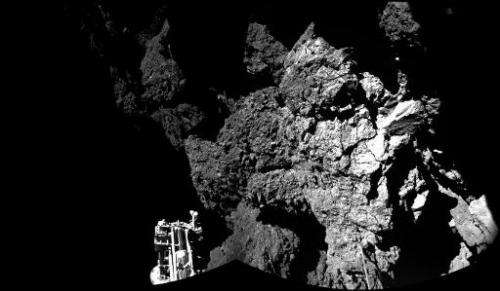A photo from the European Space Agency (ESA) on November 13, 2014 shows an image taken by Rosetta's lander Philae, which will soon be woken up by solar energy recharging its batteries as the comet on which it landed draws closer to the sun
Ground controllers will open a communications line Thursday with a robot lab perched on a comet zipping through space, hoping for signs it is alive, the European Space Agency (ESA) said Wednesday.
The 100-kilogramme (220-pound) probe Philae landed on Comet 67P/Churyumov-Gerasimenko on November 12 after a 10-year trek piggybacking on its mother ship, the orbiter Rosetta.
But the landing did not go smoothly. Philae bounced twice off the comet's hard surface before settling at an angle in the shadow of a cliff.
Philae had enough stored power in a battery for 60 hours of experiments. It sent home reams of precious data before going into standby mode when the juice ran out.
The hope is that, with Comet "67P" drawing closer to the Sun, better light conditions will recharge Philae's solar-powered batteries and it will wake up.
"Tomorrow (Thursday) we will switch on the radio receiver on Rosetta, which is the radio apparatus that communicates with Philae," ESA spacecraft operations spokesman Daniel Scuka told AFP.
It will be turned on at 0100 GMT, and the first communications window should open about three hours later, although "no one expects we will get anything immediately," Scuka said.
The channel will remain open for eight days until March 20.
Theoretically, this is the best period—with Rosetta in a good orbit close to the comet surface, and near enough to the Sun that Philae should be able to recharge.
The comet probe is "probably getting twice the amount of sunlight it was getting when we landed in November," said Scuka.
The European Space Agency's Rosetta blog said it would be "very lucky" if any signal were received right away.
"It will probably still be too cold for the lander to wake up, but it is worth trying. The prospects will improve with each passing day," it quoted lander project manager Stephan Ulamec as saying.
Rosetta's journey to the comet took more than a decade from 2004, and 6.5 billion kilometres (four billion miles).
Having placed Philae on the dusty iceball's surface, Rosetta continues to orbit 67P as it loops around the Sun.
The comet is expected to reach its closest point of some 186 million km on August 13.
Comets are primordial clusters of ice and dust that are believed to hold secrets about the birth of the Solar System and possibly the origins of water, the stuff of life, on Earth.
© 2015 AFP
























